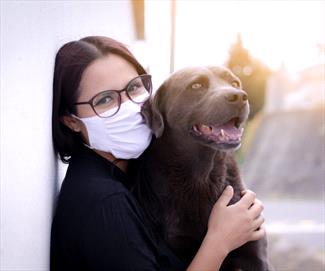Be sure to not leave a facial mask – especially a used one – within reach of your dog
Woman with facial mask and dog

Photo courtesy of Depositphotos
By now, regardless of age, hair color, or professional title, we all have a little something in our homes: face masks. While they may come in a variety of sizes, styles, and colors, to a dog they may all look like something edible. And that’s the problem. There’s a new problem in town, obstructing dogs’ stomachs and intestines: the face mask.
Dogs are known to eat things they shouldn’t. Some things we understand, like the dog that eats the loaf of bread, the just-cooked bacon, or the plate of cookies. While we wish they wouldn’t do it, we may expect it and blame ourselves for having left it within grabbing distance. But other things don’t make sense to us. Why do dogs eat rocks, socks, or clocks? How are those even appetizing? Add face masks to that list of inedibles to humans but not to dogs.
While on the face of it (get it?), masks may not seem appetizing to humans, they really can be to a dog. Perhaps you had just eaten a sandwich, with bacon, and a cookie for dessert before donning the mask. Remember, dogs have very sensitive noses. They can smell the lovely bouquet of odors trapped in the fibers of the mask, and that bouquet smells like food so the dog eats the mask.
Unfortunately, once in the stomach, it will not act like food, supplying needed nutrients to our four-legged friend. Instead, it will act like a “foreign body,” something that shouldn’t be there and is causing a problem. The mask may bunch up at the point between the stomach and the intestine, plugging it up and not allowing food to pass out of the stomach. If real food can’t go down the usual way, it’ll come back up: the dog will start vomiting food, even if it doesn’t vomit up the mask. This situation can also give the dog a constant feeling of having a full stomach, leading to a loss of appetite.
Masks may also act as a linear foreign body, one that is long and thin like string. These foreign bodies often get anchored at one point along the gastrointestinal tract, but rather than blocking the works, they cause the normal wave-like actions of the GI tract that usually move food along to be harmful instead. With each wave, rather than the mask advancing through the GI tract like food, the intestines ‘climb’ the mask. With time, the intestines will start to fold on themselves, plicating much like an accordion. This can lead to vomiting, diarrhea, a painful belly, and if it gets really bad, the intestinal contents may leak into the abdomen.
Finally, some masks contain metal wires along the nose for a better fit, or metal beads to cinch up ear loops. These metal parts can cause their own issues because of potential metal toxicity or because pointy pieces may perforate the GI tract. Regardless of how the mask causes injury, the result is one sick puppy.
To prevent this from occurring, be sure to not leave a mask – especially a used one – within reach of your dog. Also, monitor what he’s sniffing at on walks, since discarded and lost masks are not an uncommon finding along streets and sidewalks these days.
Definitely keep wearing a mask while outside of your home. They are an important part of reducing the spread of the coronavirus during the pandemic. Just be aware of the potential for harm should your dog decide to eat one.
1 Comment
Janet
January 8, 2021